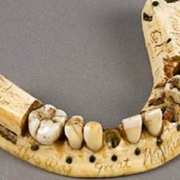Real teeth were used in the most expensive dentures and were often illegally obtained from exhumed corpses and the bodies of executed criminals (nice!).
The Battle of Waterloo in 1815 left 51,000 dead. The day after the battle a whole army of scavengers started to strip the dead of everything including their teeth. Suddenly there were mountains of teeth flooding the London markets, making real tooth dentures more affordable.
The name ‘Waterloo teeth’ came to mean any dentures made with real teeth (as in this photo). They were very sought after as they were made with teeth supposedly taken from a brave soldier cut down in his prime.
Thankfully Claudius Ash, a silver and goldsmith invented a denture to hold Porcelain teeth in, so denture wearers no longer had to wonder about the provenance of their teeth.


